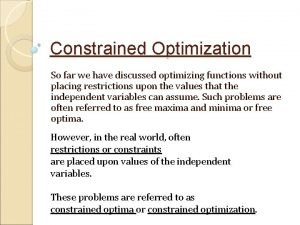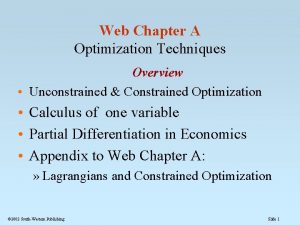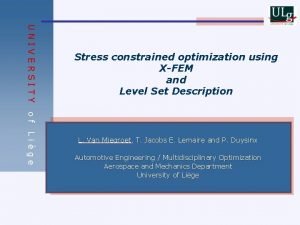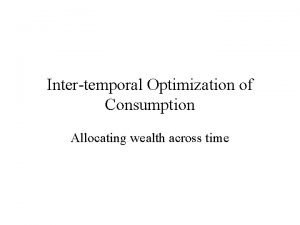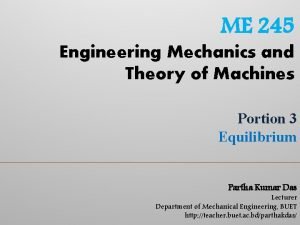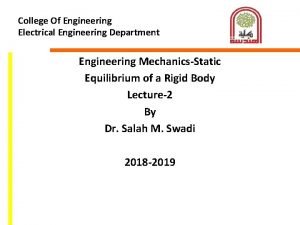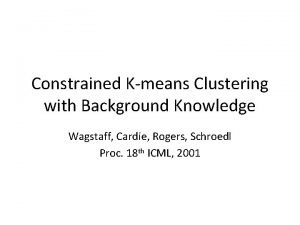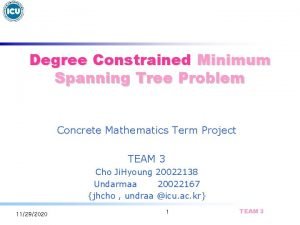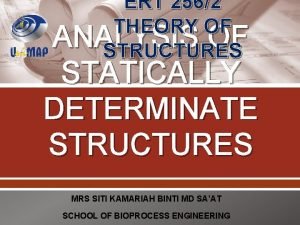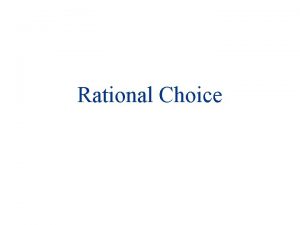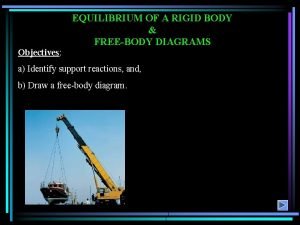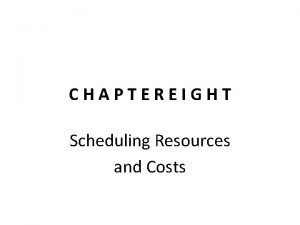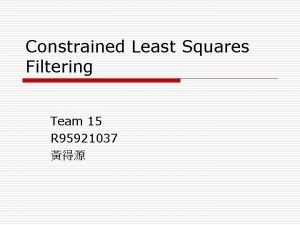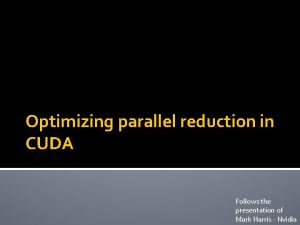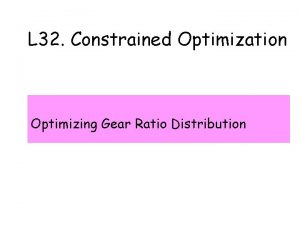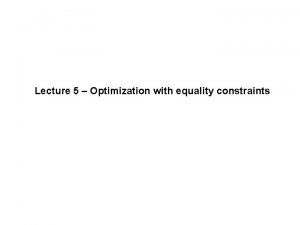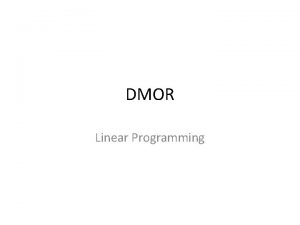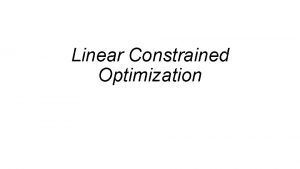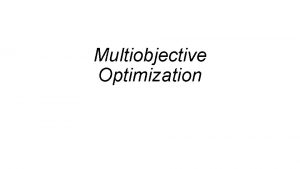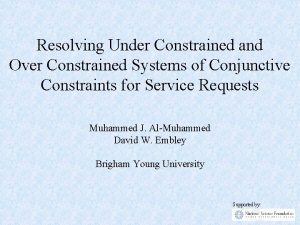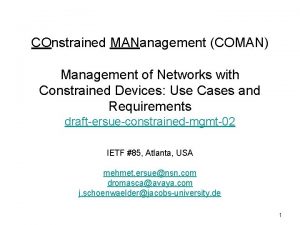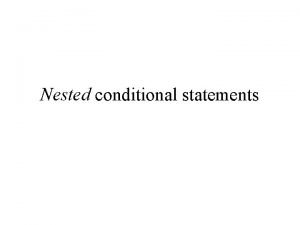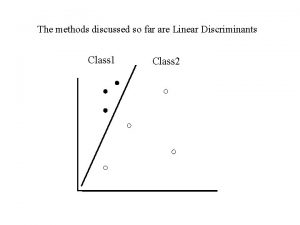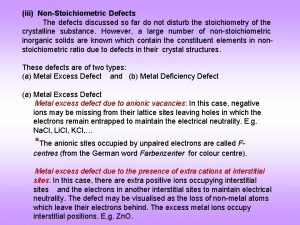Constrained Optimization So far we have discussed optimizing





























- Slides: 29

Constrained Optimization So far we have discussed optimizing functions without placing restrictions upon the values that the independent variables can assume. Such problems are often referred to as free maxima and minima or free optima. However, in the real world, often restrictions or constraints are placed upon values of the independent variables. These problems are referred to as constrained optima or constrained optimization.

Constrained Optimization Graphically, the difference between the free optima and the constrained optima can be shown as: Constrained maximum constraint Free maximum

Constrained maximum Free maximum constraint � The free optima occurs at the peak of the surface. � If we specify a specific relationship between variables and (a constraint) then the search for an optimum is restricted to a slice of the surface. The constrained maximum occurs at the peak of the slice.

Constrained Optimization � Since economists deal with the allocation of scarce resources among alternative uses, the concept of constraints or restrictions is important. � There are two approaches to solving constrained optima problems: (i) substitution method (ii) Lagrange multipliers

Substitution Method � Consider a firm producing commodity with the following production function: � Without any constraints, the firm can produce an unlimited quantity by utilizing an unlimited amount of and.

Substitution Method � But suppose the firm has a budget constraint: Let � For simplicity, assume that the maximum amount the firm can spend on these two inputs is $100. � So we have the following constraint:

Substitution Method � Suppose the economic question facing this firm is maximizing production subject to this budget constraint. � The solution via the substitution method is to substitute: ◦ First, write the constraint in terms of :

Substitution Method ◦ Then substitute this value into the production function, such that: ◦ With this substitution, the constrained maxima problem is reduced to a free maxima problem with one independent variable.

Substitution Method ◦ Now apply the usual optimization procedure: (critical value)

Substitution Method ◦ The method of substitution is one way to solve constrained optima problems. This is manageable in some cases. In others, the constraint may be very complicated and substitution becomes complex.

Lagrange Multipliers � The constrained optima problem can be stated as finding the extreme value of subject to. � So Lagrange (a mathematician) formed the augmented function. denotes augmented function will behave like the function if the constraint is followed.

Lagrange Multipliers � Given the augmented function, the first order condition for optimization (where the independent variables are , and λ) is as follows:

Lagrange Multipliers � Using the previous example: note: to be on the budget line

Lagrange Multipliers � Solving these 3 equations simultaneously:

Lagrange Multipliers � Solving these 3 equations simultaneously (cont’d):

Lagrange Multipliers � Solving these 3 equations simultaneously (cont’d):

Lagrange Multipliers � If � This , then solution yields the same answer as the substitution method, i. e. , and.

Lagrange Multipliers � Economists prefer using the Lagrange technique over the substitution method, because: (i) easier to handle for most cases and (ii) provides additional information. Namely for (ii), the value of λ has an economic interpretation. (There is no counterpart to this variable in the substitution method).

Lagrange Multipliers � Given, where C is the level of expenditures (budget = $100 in this example). here the Lagrange multiplier measures the sensitivity of to changes in the constraint (C ).

Lagrange Multipliers � 2 nd order conditions Given � 1 st order conditions for extremum:

Lagrange Multipliers � 2 nd order conditions involve second order partial derivatives expressed in the form of a determinant. � In the constraint case, we will utilize the bordered Hessian – which is the Hessian of the free optima case surrounded by the partial derivatives with respect to the Lagrange multiplier λ.

Lagrange Multipliers � 2 nd order partials:

Lagrange Multipliers � 2 nd order partials:

Lagrange Multipliers Note: partials with respect to Lagrange multiplier (λ) form the border � 2 explanatory variables and 1 constraint is the largest size bordered Hessian we will consider for this class.

Lagrange Multipliers � So the 2 nd order condition is: � Let’s now return to our previous example: ◦ Recall the critical values of and. ,

Lagrange Multipliers � What about the 2 nd order conditions?

Lagrange Multipliers Find

Lagrange Multipliers Expand by 1 st row:

Lagrange Multipliers represents a rel max.
 Constrained nodes and constrained networks
Constrained nodes and constrained networks Constrained nodes and constrained networks
Constrained nodes and constrained networks Scada transport over llns with map-t
Scada transport over llns with map-t Constrained optimization substitution method
Constrained optimization substitution method Constrained and unconstrained optimization in economics
Constrained and unconstrained optimization in economics Constrained optimization
Constrained optimization Constrained optimization
Constrained optimization Simile in an elementary school classroom
Simile in an elementary school classroom Sour cream walls is an example of pun
Sour cream walls is an example of pun In a kingdom far far away
In a kingdom far far away Far far away city
Far far away city Simple machines engineering mechanics
Simple machines engineering mechanics Improperly constrained
Improperly constrained What is related constrained diversification
What is related constrained diversification What are the impacts of resource constrained scheduling
What are the impacts of resource constrained scheduling The cable of the tower crane is subjected to 840
The cable of the tower crane is subjected to 840 Constrained k-means clustering with background knowledge
Constrained k-means clustering with background knowledge Operational relatedness is created by
Operational relatedness is created by Degree constrained spanning tree
Degree constrained spanning tree Improperly constrained
Improperly constrained Rational constrained choice
Rational constrained choice Improperly constrained
Improperly constrained Scheduling time-constrained projects focuses on resource
Scheduling time-constrained projects focuses on resource Explain the constrained least square filtering.
Explain the constrained least square filtering. Csp algorithm
Csp algorithm Simulation phases of systemverilog verification
Simulation phases of systemverilog verification How is economizing different from optimizing?
How is economizing different from optimizing? Dr moza
Dr moza Syncthreads
Syncthreads Optimizing parallel reduction in cuda
Optimizing parallel reduction in cuda



